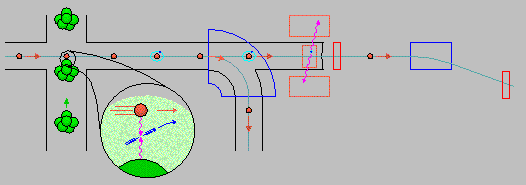Experiment description

- Antiprotons (red) circulate in the
LEAR
ring
- many millions per second
- deflected by dipoles (blue)
(there are four of those, one in each corner of the accelerator,
here, only one is plotted)
- Xenon clusters (atoms freezed together) cross the path of the
antiprotons
- When an antihydrogen atom (red with blue positron circulating around
it) is produced
(see Antihydrogen production)
- it is not deflected in the dipole, goes straight
through
- it leaves the LEAR ring
- In the first detector (red box)
- the antihydrogen is 'ionized', i.e. positron and antiproton are separated
- the positron
- sticks in this detector
- its former kinetic energy is measured
- annihilates with an electron
- 2 photons of 511keV each are emitted back-to-back
and measured
- the antiproton
- passes several detectors, measuring
- The combination of
with right velocities and energies
is a clear and sufficient indication that an
antihydrogen atom has been
produced and detected.
Specialists read the preprint
